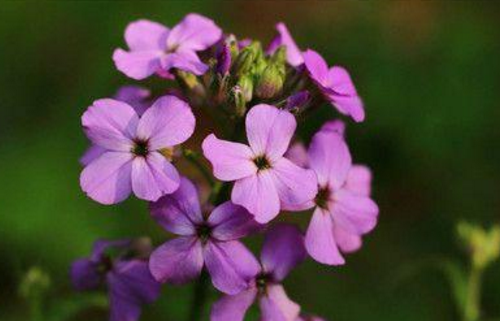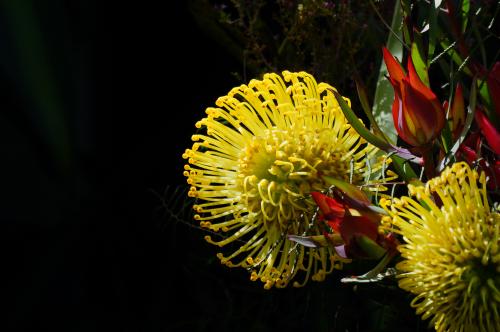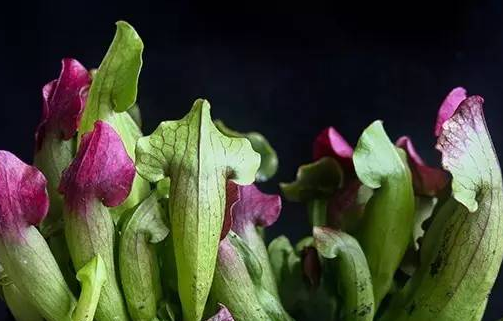Culture method of blue incense mustard
Light
Blue mustard likes the sun very much, and it is possible to let it receive light all day during breeding, or in a slightly dark environment, but pay attention to the fact that in summer, because the temperature is too high and the sun is too strong, you can not let the plant be placed in direct sunlight. Give it proper shade so as not to burn the plant leaves.

Water and fertilizer
As the blue mustard is a dwarf plant, branches and leaves are hairy, so be careful when watering and fertilizing, and remember not to let water and liquid fertilizer splash on the leaves. If there is spatter, wipe it off in time so as not to burn or rot the plant.
Soil
Blue mustard soil requirements are relatively strict, need loose, breathable and well-drained soil, this kind of soil can be configured by itself, you can also go to the florist to buy special nutrient soil for blue incense mustard.
The above is about the introduction of how to raise blue incense mustard. Let's take a look at what else we need to pay attention to.
Culture methods and matters needing attention of blue incense mustard
Culture methods of blue incense mustard temperature and light
Blue mustard likes to grow in a sunny and cool climate. Keeping a low temperature can form a good plant shape. Generally, it grows better in full light to slightly overcast conditions, but in hot summer, proper shading and ventilation are needed.
Water and fertilizer
As the blue mustard is a dwarf plant, branches and leaves are hairy, so watering and fertilization should pay attention to avoid contaminating the leaf surface, and wipe off the residual water and fertilizer on the leaf surface in time, otherwise it will easily lead to branch and leaf rot.
Soil
It is appropriate to use a medium with good drainage and loose ventilation.
Matters needing attention in the culture of blue incense mustard
When the environmental conditions of the management are not so ideal, it is best to spray the dwarf element for two times, which can prevent the growth of blue mustard and control the plant shape.
Normally, blue mustard has no serious disease and insect pest problems. It should be noted that reasonable and good row spacing must be maintained in the cultivation process of blue mustard to avoid affecting plant shape and causing diseases and insect pests due to crowding.
Withered flowers and stems should be removed in time to make the second season blossom more luxuriantly. Blue mustard blossoms luxuriantly in the spring of the second year, and the ornamental effect is good, so it is suitable to match with other flowers and plants blooming at the same time, such as cow's eye chrysanthemum is a good choice.
Blue incense mustard Hesperis matronalis blue incense mustard map guide: how to raise blue incense mustard / how to propagate blue incense mustard the culture method and precautions of blue incense mustard Hesperis matronalis blue incense mustard the introduction of blue incense mustard proper name blue incense mustard Eurasian incense mustard, native to Eurasia, but eastern North America has been introduced for many years and has grown in many places in the east. It can be planted in a wide range of areas in China, most of the Yangtze River basin and the middle and upper reaches of the Yellow River (most of the warm winter areas in the south and north). Blue mustard flowers have a fresh, lilac-like fragrance, especially in the evening. The morphological characteristics of blue incense mustard are perennial or biennial herbs with short growth period. Vertical, many branched, ca. 60-90 cm tall, usually not more than 120 cm. The width of the crown is 30cm to 60cm. Leaf margin serrate, elliptic to lanceolate, dark green. The flowers are white, lavender or purple, 1.2cm to 2.4cm in diameter, 4 petals, racemes, very similar to February blue. And because the flowers and Fu Lukao are also similar, they are all clustered on a long stalk, so they are often called "Ye Fu Lukao", but the petals of blue incense mustard are one less than that of Fu Lukao. Flowers have a fresh, lilac-like fragrance, especially in the evening. The number of flowers in clusters per plant is more blue than that in February, and the flowers are of the same shape and color. Seeds are smaller than February blue, with about 540000 seeds per kilogram, while February blue is generally less than 400000. The ecological habit of blue incense mustard is strong adaptability, in full light to slightly overcast conditions, moderately moist, well-drained soil. It is best to plant in partial shade in a hot summer climate. Through a large number of self-sowing reproduction, it can be retained in the planting site for many years. It blossoms luxuriantly in the spring of the following year and works well, especially with other flowers and plants that bloom at the same time, such as cow's eye chrysanthemum. Timely removal of withered flowers and stems can make the second season bloom luxuriantly. Key points of cultivation techniques of blue-scented mustard the blue-scented mustard can grow in sufficient light or slightly shady ground, and it is often used for biennial cultivation with low maintenance requirements. The flowering period is early spring, slightly later than February orchid, but the flowering period is longer than February orchid. The flowering period in the middle and lower reaches of the Yangtze River is from mid-late March to June. It is summarized that blue mustard needs a cool climate in summer. Autumn sowing is often used in the middle and lower reaches of the Yangtze River and the south of the Yangtze River because of the hot summer, and the seedlings can survive the winter above 0 degrees, so that they can blossom in spring. Transplant / upper pot blue mustard seedlings are not resistant to transplantation, so it is better to be early rather than late, and try to keep the roots of the seedlings intact. It is often transplanted into the pot within 4 weeks after emergence, and the variety 'Palona' should use a small basin of about 10 years, as well as a pot medium with good drainage and loose ventilation. Temperature-regulated seedlings have a higher temperature when they emerge, which can be at 22 degrees. It is best to keep 18 ℃ at the initial stage of transplanting. Once the root system elongates, it can be reduced to about 15 ℃, so that it can blossom in about 10 weeks. Keeping a low temperature can form a good plant shape, and Flukao can withstand a low temperature of about 0 ℃, but its growth period is relatively long. Take care of blue mustard should grow in sunny, cool climate conditions, so that there is no need to use dwarf to control plant shape. When the environmental conditions are not ideal, spraying 1 Mel twice can prevent overgrowth. In the process of cultivation, good plant row spacing must be maintained to prevent crowding and affecting plant shape and producing diseases and insect pests. The plant is short and the branches and leaves are hairy, so watering and fertilization should avoid contaminating the leaves to prevent the branches and leaves from rotting. The whole growth and development period is 14 weeks, which is related to the size of the basin, light conditions and seedling time. Because of the short growing period, blue-scented mustard can be sown many times in spring or autumn to prolong the viewing period. The root base is lignified and maintained for many years, which can sprout new buds on the propagating tuberous roots and continue to blossom in the second and subsequent seasons. But sowing and reproduction are the most ideal. Sowing is the most ideal in Jiangsu, Zhejiang and Shanghai from August to September. Although it can also reproduce by itself, the overall effect may not be very good. It can only be used in rough and natural landscape areas. Disease control of blue incense mustard there is no serious disease and insect pest problem. The distribution area of blue mustard is native to Eurasia, but it has been introduced in eastern North America for many years and has grown in many places in the east. It can be planted in a wide range of areas in China, most of the Yangtze River basin and the middle and upper reaches of the Yellow River (most of the warm winter areas in the south and north). The bright and fresh blue of blue mustard is very rare in spring flower species. It is an excellent plant for natural sites, road slopes and courtyards. It can also be used as a flower border, but in the summer after blooming, like February blue, leaves fall, so annual or slow-growing perennials are needed to fill the gap. In general, unicast applications can also be mixed. Mixed with purple jasmine, echinacea, black chrysanthemum, scarlet lip, a bunch of blue in the positive area, and planted with Hosta and Ophiopogon in the semi-overcast area. In addition, blue mustard is also a very good pasture plant. The cultural background name of the blue incense mustard comes from the blue incense mustard, because the flowers are also similar to the Fu Lukao, both of them are clustered on a long stalk, so they are often called "Ye Fu Lu Kao", but the petals of the blue incense mustard are one less than that of Fu Lukao. The flower language of blue mustard: competition. Pictures of blue mustard
- Prev

Culture methods of Imperial Flower
The first aspect-the imperial flower likes the environment with plenty of light, so make sure that the imperial flower has enough light and is usually placed on the balcony and in a ventilated and sunny place. The second aspect-- the soil for planting imperial flowers needs loose and well-drained sandy soil, which is beneficial to the growth of imperial flowers.
- Next

Common insect pests of bottle grass and their solutions
Bottle grass is easily attacked by red spiders, aphids and root powder scale insects in the process of culture. in order to raise our bottle grass well, we should pay attention to pest control. Red spider treatment method: dilute avermectin 2000 times or dimethoate 1000 times, shake well and spray in a spray can.
Related
- Fuxing push coffee new agricultural production and marketing class: lack of small-scale processing plants
- Jujube rice field leisure farm deep ploughing Yilan for five years to create a space for organic food and play
- Nongyu Farm-A trial of organic papaya for brave women with advanced technology
- Four points for attention in the prevention and control of diseases and insect pests of edible fungi
- How to add nutrient solution to Edible Fungi
- Is there any good way to control edible fungus mites?
- Open Inoculation Technology of Edible Fungi
- Is there any clever way to use fertilizer for edible fungus in winter?
- What agents are used to kill the pathogens of edible fungi in the mushroom shed?
- Rapid drying of Edible Fungi

